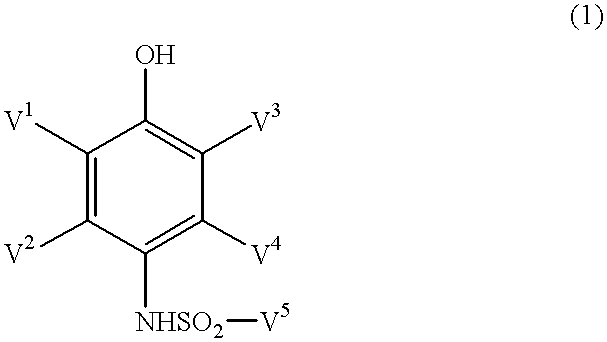Photothermographic material and method for forming images
a technology which is applied in the field of photothermographic material and image formation method, can solve the problems of not having the same characteristics as image-forming temperature, image stability and color tone, and not necessarily having suitable characteristics
- Summary
- Abstract
- Description
- Claims
- Application Information
AI Technical Summary
Benefits of technology
Problems solved by technology
Method used
Image
Examples
example 1
Preparation of PET Support
Polyethylene terephthalate having intrinsic viscosity of 0.66 (measured in phenol / tetrachloroethane=6 / 4 (weight ratio) at 25.degree. C.) was obtained in a conventional manner by using terephthalic acid and ethylene glycol. The product was pelletized, dried at 130.degree. C. for 4 hours, melted at 300.degree. C., then extruded from a T-die and rapidly cooled to form an unstretched film having such a thickness that the film should have a thickness of 175 .mu.m after thermal fixation.
The film was stretched along the longitudinal direction by 3.3 times at 110.degree. C. using rollers of different peripheral speeds, and then stretched along the transverse direction by 4.5 times at 130.degree. C. using a tenter. Then, the film was subjected to thermal fixation at 240.degree. C. for 20 seconds, and relaxed by 4% along the transverse direction at the same temperature. Then, the chuck of the tenter was released, the both edges of the film were knurled, and the film ...
example 2
Preparation of Organic Acid Silver Salt Emulsion A
In an amount of 933 g of behenic acid was added to 12 L of water, and added with 48 g of sodium hydroxide and 63 g of sodium carbonate dissolved in 1.5 L of water, while the mixture was maintained at 90.degree. C. After the mixture was stirred for 30 minutes, the temperature of the mixture was lowered to 50.degree. C., and the mixture was added with 1.1 L of 1 weight % N-bromosuccinimide aqueous solution, and then gradually added with 2.3 L of 17 weight % silver nitrate aqueous solution with stirring. Then, the temperature of the mixture was lowered to 35.degree. C., and the mixture was added with 1.5 L of 2 weight % potassium bromide aqueous solutions over 2 minutes with stirring, then stirred for 30 minutes, and added with 2.4 L of 1 weight % N-bromosuccinimide aqueous solution. This aqueous mixture was added with 3300 g of 1.2 weight % polyvinyl acetate solution in butyl acetate with stirring, and then left standing for 10 minutes...
example 3
Preparation of Silver Halide Emulsion
Emulsion A
In 700 ml of water, 11 g of phthalized gelatin, 30 mg of potassium bromide and 10 mg of sodium benzenethiosulfonate were dissolved. After the solution was adjusted to pH 5.0 at a temperature of 55.degree. C., 159 ml of an aqueous solution containing 18.6 g of silver nitrate and an aqueous solution containing 1 mol / L of potassium bromide were added by the control double jet method over 6 minutes and 30 seconds while pAg was maintained at 7.7. Then, 476 ml of an aqueous solution containing 55.5 g of silver nitrate and an aqueous halide salt solution containing 1 mol / L of potassium bromide were added by the control double jet method over 28 minutes and 30 seconds while pAg was maintained at 7.7. Then, the pH was lowered to cause coagulation precipitation to effect desalting, 0.17 g of Compound A and 23.7 g of deionized gelatin (calcium content: 20 ppm or less) were added, and pH and pAg were adjusted to 5.9 and 8.0, respectively. The grain...
PUM
| Property | Measurement | Unit |
|---|---|---|
| temperature | aaaaa | aaaaa |
| boiling point | aaaaa | aaaaa |
| diameter | aaaaa | aaaaa |
Abstract
Description
Claims
Application Information
 Login to View More
Login to View More - R&D
- Intellectual Property
- Life Sciences
- Materials
- Tech Scout
- Unparalleled Data Quality
- Higher Quality Content
- 60% Fewer Hallucinations
Browse by: Latest US Patents, China's latest patents, Technical Efficacy Thesaurus, Application Domain, Technology Topic, Popular Technical Reports.
© 2025 PatSnap. All rights reserved.Legal|Privacy policy|Modern Slavery Act Transparency Statement|Sitemap|About US| Contact US: help@patsnap.com



